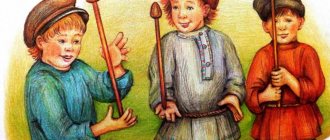The games in the selection are arranged by age. But do not forget that the manufacturer’s recommendations are only a rough guide. Often younger children also cope quite successfully with the game. Whether a child will like a new activity largely depends on his interests.
Most of the options presented are special editions designed for young players. However, instead of junior versions, you can safely take regular, adult ones. With a slight simplification of the rules, children will easily understand them, and when they grow up, they will be able to play on equal terms with their parents.
UNO Junior
@"Games and Toys" / YouTube
- Age: 3+.
- Number of players: 2–10.
- Game duration: from 15 minutes.
One of the most popular games with which many begin their acquaintance with the world of board games. UNO is loved for its fast and addictive gameplay, excitement and a lot of fun from chatting at the table.
This version is distinguished by colorful cards, where, in addition to numbers, funny animals are drawn. Older children use the entire deck, and for the youngest players there is a simplified mode without special effects. The rules are the same: get rid of the cards as quickly as possible and do not forget to shout “Uno!” when the last one remains in your hands.
Price: 329 rubles.
Buy
Barabashka's childhood
@"Board Games - Lifestyle" / YouTube
- Age: 4+.
- Number of players: 2–6.
- Duration: from 15 minutes.
A game designed for children to develop attentiveness and quick thinking. Thanks to simple rules and funny colorful characters, “Barabashka’s Childhood” risks being liked by a child and becoming a favorite board game.
The main character and his village friends are depicted on the cards in different colors. Participants turn over the cards one by one, and then quickly grab the figures with the correct color that are in the picture. The fastest one gets a point, and the victory goes to the one who collects the most items by the time the deck is empty.
Price: 1,107 rubles.
Buy
Children of Carcassonne
@"Games and Toys" / YouTube
- Age: 4+.
- Number of players: 2–4.
- Duration: from 20 minutes.
A colorful version of the cult strategy that even kids can play. The simplified rules are easy to learn, and the gameplay does not suffer at all - it will be interesting even for adults.
Opponents take turns turning over tiles with landscapes, buildings and their inhabitants, laying out the elements on the table so that the paths coincide. When one of the paths closes or hits an obstacle, players can place their figures if their colors are on the cards. The winner is the one who “settles” all his little people before others.
Price: 1,932 rubles.
Buy
Competitions for children 12-13 years old
Catapult
The guys are divided into teams with the same number of people. Everyone has several stones in their hands. Teams stand at a certain distance from each other. Participants take turns throwing their own pebble, trying to do it so that the pile is as “clustered” as possible. Whichever of the guys gets the most friendly pile of stones (that is, they will lie as close to each other as possible) will receive the title of winner, and at the same time a prize.
Steel press
In this competition, children are divided into pairs and take turns pumping the press once. Whoever gives up first loses. And the winners in each pair receive prizes.
Sardines in a jar
Participants are divided into teams, and a catcher is chosen in each of them. He is given an elastic band tied into a ring. The diameter of the ring depends on the number of participants in one team. The remaining participants (“sardines”) take places in different parts of the site. The game begins and the catcher puts the ring on one player and runs with him to the next. Now there are two players in the ring, together with the catcher they run to the next one and so on until all team members are in the ring. The first catcher to collect his “can of sardines” wins.
Housewarming
Players are divided into equal teams. In front of each team hangs a sheet of Whatman paper with a schematic drawing of a house and windows. The task of each participant is to run up to their sheet in turn, draw a little man in one of the windows, and then return back. The first team to fill their house completely wins.
Hunting wild animals
For this competition you need to print out pictures of wild animals, for example, wild boar, fox, wolf, hare and so on. Pictures are pasted on the children, then two hunters are selected and given a weapon (a simple ball). At the command of the leader, the guys begin hunting, that is, the hunters throw a ball at the animals, which in turn try to escape. If the hunter hits the animal, the animal is eliminated from the game and the hunter gets a point. And whichever hunter collects the most points will be recognized as the best and receive his prize.
Encryption
Players receive a task - a word that needs to be deciphered. It can be absolutely anything. You need to come up with a sentence so that each word in it begins with the next letter of this task word. For example, if the word “SKODA” is given, then it can be deciphered as “Six Cows Discovered by the Detective Agency.” The author of the most witty transcript wins.
Happy Life Calendar
Each of the participants in this competition can show their imagination and ingenuity and come up with their own calendar of a fun life. Each child must invent 12 new months of his own and tell in a nutshell what can be done during this time. Whoever has the most original and unique calendar wins. For example, January - sankikatanyar, February - snow and ice cream, March - chocolate, April - caramel, and so on.
Cup of popcorn
At this age, children love sweets of any kind. Each participant receives a glass of popcorn, which they will need to eat faster than others. You just have to eat with your hands tied. Reade set Go! Whoever is first wins.
Leap into the future
The presenter prepares the markings (with chalk or tape) and, starting from, for example, 150 cm, places numbers for every 5 cm, that is, 150 - 1, 155 - 2, 160 - 3, 165 - 4, 170 - 5 and so on up to 2 meters or more. Each of the participants takes turns making a jump, on which number he lands, and then receives from the presenter according to the price list, for example, 1 - sucking candy, 2 - pen, 3 - notebook, 4 - chocolate bar, 5 - pack of crackers, and so on.
I see
The participant says: I see... and describes the object that he means, for example, red, round, big, and the guys must guess what the participant means, for example, an apple. The one who guessed says next: I see... a square, multi-colored, beautiful (picture), whoever guessed guesses next. The guys who have the most guessed items will receive prizes.
Alias Junior
@Board Games – Lifestyle / YouTube
- Age: 4+.
- Number of players: 4 or more.
- Duration: from 30 minutes.
An exciting game for the development of associative thinking, imagination and logic, which will give a storm of emotions to players of all ages.
The same rules apply here as in adult Alias. Using synonyms, antonyms and descriptions, participants guess each other's words from the cards without naming them. Whoever guessed correctly gets a point, and the winner is the smartest one.
Price: 890 rubles.
Buy
Methodological recommendations for teachers “Outdoor games for children 7-14 years old”
Outdoor games for children 7-14 years old
This methodological manual may be useful and interesting
for educators and social educators.
Purpose:
outdoor play refers to those manifestations of play activity in which the role of movements is clearly expressed. Outdoor play is characterized by active creative motor actions motivated by its plot. These actions are partially limited by rules (generally accepted, established by the leader or played) aimed at overcoming various difficulties on the way to achieving the goal. The activity of various analyzers, clearly expressed in outdoor games, creates favorable opportunities for training the functions of the cerebral cortex, for the formation of new temporary, both positive and negative connections, and for increasing the mobility of nervous processes. Particularly valuable in terms of health benefits is year-round outdoor games: those involved become more seasoned, and the flow of oxygen into their body increases. The game has a great impact on the formation of personality: it is such a conscious activity in which the ability to analyze, compare, generalize and draw conclusions is manifested and developed. Modern children move little, play outdoor games less than before due to their attachment to TV and computer games. The number of open spaces for games is also decreasing. Parents and educators are increasingly concerned about how, where and when to provide children with opportunities for active and creative play. And in order to maintain children’s interest in such games, they must recognize them, and the teacher’s task is to help them with this.
Description:
the game is the basis of knowledge of the world, performing the functions of learning, socialization, relaxation, relaxation, energetic sublimation, transmission of experience, etc. It can be said without exaggeration that all ages are submissive to the game.
Goal:
promoting the development of physical qualities: speed, agility, strength, endurance, flexibility.
Objectives:
1. To form vital motor skills and abilities; 2. Cultivate will, endurance, discipline and other qualities; 3. Master individual sports-technical techniques and their combinations; 4. Instill a love of sports.
"Buckbeak"
Educational purpose of the game:
formation of creative thinking, improvement of interhemispheric connections of the brain.
Pedagogical significance:
the game develops spatial and visual imagination, intelligence.
Preparing for the game:
children stand in one line or semicircle.
On the contrary, they, so that everyone can see him, become the head of the game. Contents and course of the game:
the leader tells that the players must portray a fairy-tale animal, guided by the hint contained in its name, in which the first and second parts of the word indicate parts of the body, and they must place their right hand on the part of the body contained in the first part of the word , and the left hand on the part of the body whose name is in the second part of the word.
For example, the leader says: “Ukhonos!”, To which the players must touch their ear with their right hand and their nose with their left hand. Rules:
1. The right hand is placed on the part of the body that is named in the first part of the word, denoting the name of the fabulous animal, and the left hand is placed on the part of the body named in the second part of the word.
Game option:
the players split into pairs and stand opposite each other.
One of them shows a fabulous animal, and the other must quickly answer which animal he showed and if he answers correctly, he gets a point. After this, the other player shows, and the one who is watching answers. The game continues until a predetermined number of points. Methodological recommendations:
1. Start playing the game with a simple version, reporting only the names associated with one part of the body according to the proposed scheme: 1.1. "Nose-ear"; "Rhino"; "Rhinosae"; “Rhinosot”, “Nosenos” - the right hand touches the nose, and the left hand touches the ear, arm, leg, mouth, nose. 1.2. "Uhorot"; "Ukhonos"; "Ukhoruk"; "Ukhonog"; “Ear-ear” - the right hand touches the ear, and the left hand touches the mouth, nose, arm, leg, ear 1.3. "Rukonos"; "Rukoukh"; "Rukoruk"; "Armfoot"; “Hand” - the right hand touches the other hand, and the left touches the nose, ear, arm, leg, mouth. 1.4. "Nogouh"; "Nogorot"; "Nogonog"; "Nogoruk"; “Nogorot” - the right hand touches the leg, and the left hand touches the ear, mouth, leg, arm, mouth. 2. The most difficult version, in which all twenty varieties of fairy-tale animals are found, should be shown only to trained players. 3. It is recommended that teachers use the game during physical education sessions during classes.
"The Tsar and the Workers"
Educational purpose of the game:
formation of creative thinking, development of cognitive abilities.
Pedagogical significance:
the game develops imagination, visual memory, attention, resourcefulness, and spatial orientation.
Inventory:
chair.
Preparation for the game:
a “king” is selected, who takes a place at one end of the field behind the front line, two people are selected from among the players - this is the “royal retinue”, who are located next to the king.
All the other players are workers who come to the king to hire a job. Contents and course of the game:
at a signal from the leader, the workers approach the king and say:
“Hello, father, our king is our father and sovereign!”
The king greets:
“Well, great - well done, you can immediately see the daredevils!”
The workers answer:
“We are not just great guys, but we are also smart at work!”
The king says:
“I need workers, but not all of them are important!
I need someone to do two things at once when ordered! If things don’t work out, I’ll put you all in prison!” The workers answer:
“You give us the job, and sit and check it yourself!”
After this, the king gives the workers a task, the retinue shows how it needs to be completed, after which all the players complete the task, and the “retinue” watches carefully, and those who did not complete the task are taken to prison, where they perform the work with which failed.
Methodological recommendations:
1. The given tasks are arranged in order of difficulty, start with the simplest ones.
2. Remember, tasks can be absurd and funny, which contributes to the development of motor imagination. 3. Learn the text before starting the game or use a cheat sheet. 4. To create a situation of success, you need to start with simple and accessible tasks. Rules:
1. Workers who fail to complete the task are taken to prison by their retinue, where they try to learn how to do the work that they were unable to do.
2. If the workers imprisoned have mastered the assigned work, they can turn to their retinue with the words: “We worked for a very long time and learned how to work, we didn’t waste our time in vain - everything for the king’s father!”
The retinue watches, the worker does the job correctly, and if its quality suits them, the player can join the others and continue the game.
3. The player, if he completes the tasks without errors, becomes king when the game is repeated. Sample tasks:
1. Use your right (left) hand to cut wood, and pound nails with your left (right) hand! 2. Use your left (right) hand to cut wood, and cut hay with your right (left) hand! 3. Use your right (left) hand to drive away flies, and slurp cabbage soup with your left (right) hand! 4. Collect mushrooms with your right (left) hand, and rake in the heat with your left (right) hand! 5. Forge the horse with your right (left) hand, and hit the horse’s back with a broom with your left (right) hand! 6. Pound water in a mortar with your right (left) hand, and knead the dough with your left (right) hand! 7. Sip cabbage soup with your right (left) hand, and play the piano with your left (right) hand! 8. Write with your right (left) hand, and erase with your left (right) hand! 9. Drive away the flies with your right (left) hand, and urge the horse on with your left! 10. Chop wood with your right (left) hand, and grind meat with your left (right) hand! 11. Dance with your feet and learn to read and write with your hands! 12. Stomp your feet and clap your hands.
13. Knead the dough with your feet, and make me laugh with your hands! 14. Swim with your right (left) and wash the floors with your left (right).
"Find your match"
Educational purpose of the game:
repetition and formation of communication skills and within team interaction.
Pedagogical significance of the game:
the game develops visual memory, attention, resourcefulness.
Inventory:
sneakers, sneakers, shoes, etc.
Preparing for the game:
the players are divided into teams of five to seven people and stand behind the front line as during relay races.
On the contrary, at a distance of 9-12 meters, a hoop is placed into which participants must put their shoes on their right (left) foot. Contents and course of the game:
at the signal from the leader, the players must jump on one leg to the hoop, find their shoes, put on their shoes and go back, passing the baton to the next participant.
Rules of the game:
1. The player must take only his own shoes and put them on;
before turning back. 2. The winner is the team that completed the task correctly and without errors. 3. You can’t throw other people’s shoes around. 4. If a player brings someone else’s shoes, he must take them back immediately; in place. Game option:
The player who stands first does not take off his shoes, but at a signal looks at the shod foot of the player who stands second, remembers what he was wearing, runs and finds the shoe from his foot and brings it;
to his player, who puts on his shoes, remembers what shoes the third player had, runs and brings his shoes, etc., until the whole team is wearing shoes. The player can throw the pair he finds, and the next player must throw it; catch. It can be agreed that any player can bring shoes of several people (for example, the second and third player). Methodical recommendations:
1. To increase the difficulty, you can deliberately instruct one part of the team to remove the shoes from the left foot, and the others from the right foot. 2. Remember, the game must be played after preliminary training and pay attention to the correct placement of shoes (they must be fully dressed). 3. Hold the game during tourist rallies or sports festivals in the camp. 4. You can also put shoes that do not belong to any of the players, which will make the game more emotional.
"Rubber"
Educational purpose of the game:
formation of spatial imagination.
Pedagogical significance:
the game develops visual memory, attention, spatial imagination, resourcefulness, spatial orientation, and determination.
Equipment:
a long piece of elastic band tied at the ends, two chairs.
Preparing for the game:
the players are divided into threes, with two players putting an elastic band on both legs and stretching it;
so that a narrow rectangle is formed. Contents and course of the game:
the jumper steps on the elastic bands or jumps between them in a certain sequence, using the following options: 1. Jump without stepping on the elastic band, while it ends up between the legs.
2. Jump inside. 3. Inside, the legs cross. 4. Legs cross on the outside. 5. Jump and roll over. 6. Jump by stepping on rubber bands. 7. Jump over both elastic bands. 8. Stretch the elastic bands to the sides, spreading your legs wide as you jump. Rules:
1. The player must perform a pre-planned combination of jumps.
Methodical recommendations:
1. You need to start by learning individual elements. 2. Give us the task at home, since you can improve in this game on your own, using chairs to support the elastic band. 3. Since the game is traditionally considered a maiden game, conduct it; better with girls. 4. Make sure that the game participants come up with jumping options themselves.
“Guess who threw it?”
Educational purpose of the game:
formation of intuition and ability to analyze.
Pedagogical significance:
the game develops observation and attention.
Equipment:
volleyball.
Preparing for the game:
the players form a semicircle, a driver is selected from among them, stands in the middle of the semicircle, stands with his back to the semicircle and closes his eyes.
Contents and course of the game:
the leader walks around the circle and quietly gives the ball to one of the players, who throws it at the feet of the leader.
As soon as the ball touches the driver’s feet, he opens his eyes, turns around and tries to guess who threw the ball at him. Rules:
1. If the driver guessed the player who threw the ball, they change places.
2. The driver should not open his eyes until the ball touches his feet. 3. You cannot throw the ball above your waist. Game option:
The players are divided into two teams, which line up at a distance of four meters from each other.
Players on one team turn around and close their eyes. Players on the other team can pass the ball to each other, after which one of them rolls the ball along the floor, trying to hit the feet of a player on the opposing team. As soon as the ball touches the player, he opens his eyes and tries to guess who rolled the ball. The rest of the team players turn in a circle. If the player guesses correctly, his team gets a point, after which the teams change roles, and the players of the other team roll the ball. The team that gets the most points within the set time wins. Methodological recommendations:
1. Remind the players that the ball can be rolled on the floor rather than thrown. 2. Be careful not to throw the ball too hard.
"Ring"
Educational purpose of the game:
formation of expressive speech skills.
Pedagogical significance:
the game develops observation, attention, imagination, and resourcefulness.
Inventory:
ring.
Preparing for the game:
children stand in a circle, connecting their palms with a boat, and a driver is selected from among them, holding a ring or an object that replaces it.
Contents and course of the game:
the driver approaches each of the players in turn, pretending that he is passing the ring, also holding his hands with a boat.
While the driver walks around the children, they say a recitative: Ring, ring, rolled off the porch Ring, ring, rolled off the porch Whoever finds the ring, happiness will come to him!
Whoever finds the ring will find happiness! Ring, ring, go out onto the porch! After pronouncing the recitative, the one who has the ring turns his back to the circle, extending his hand forward with his palm up, showing the ring lying on his palm.
Two players standing next to the owner of the ring quickly run in opposite directions around the circle, trying to get ahead of each other and be the first to take the ring. Rules:
The one who first takes the ring from the palm becomes the driver.
Methodological recommendations:
1. Learn the text of the recitative with the children in advance. 2. Act as the driver yourself.
"Rainbow"
Educational purpose of the game:
developing the ability to hold yourself confidently.
Pedagogical significance:
the game develops attention, imagination, and resourcefulness.
Preparing for the game:
children are located in one line behind the starting line, a driver is selected from among them, who stands opposite the players.
Contents and course of the game:
the driver calls any color he likes, and the children must find some item of the same color in their clothes and put it on it;
hand and run across the other line. If there is no such color, then players must pretend that there is a color and try to “illegally” penetrate the line. The driver tries to identify and insult the offender. Rules:
1. The driver freely lets through those who have the named color in their clothes.
2. Players who are tainted by the driver become his assistants. 3. The game continues until two or three people remain, who are declared winners. Methodical recommendations:
1. When playing this game, the driver needs to pay attention to the color of the players’ uniforms, and focus on the most common colors.
“Stop arrogant!”
Educational purpose of the game:
improving the eye, the ability to correctly determine the distance to an object.
Pedagogical significance:
the game develops observation, attention, imagination, and resourcefulness.
Contents and course of the game:
children listen to the driver, who names the first and last letter of the hidden word, after which he clarifies which group of objects the hidden word belongs to.
The first one who guessed correctly shouts out the word, and if the answer is correct, he quickly runs away, and the player who guessed must say the words: Stop, arrogant, period, comma, one, two, three - don’t run, don’t look!
When you say
“look,”
the driver must stop quickly.
The player “by eye” determines the distance to the leader in steps, using at least two types of steps: Types of steps:
1. “Giant steps” - the maximum steps possible for a given player with a flight phase.
2. “Large steps” - maximum steps without a flight phase. 3. “Small steps” - ordinary steps. 4. “Ant steps” - steps equal to the length of the foot. Rules:
1. When determining the distance, it is necessary to use two types of steps.
2. If a player stains another player by taking the specified number of steps, then he becomes the new driver. Methodological recommendations:
1. Prepare cards with variants of tasks in advance, without expecting that the children themselves will be able to quickly come up with the necessary words. 2. Divide the players into more teams, this will increase interest in the game.
Cheese castle
@IgraJby / YouTube
- Age: 5+.
- Number of players: 2–4.
- Game duration: from 15 minutes.
An atmospheric game that develops memory and spatial imagination, originally created for young board gamers. “Cheese Castle” is interesting even as a separate toy: a beautiful labyrinth-fortress has removable roofs and moving corridors. Inside there are funny little mice, which, if moved carelessly, can end up in dungeons.
The adventurers' task is to collect a collection of cheeses hidden in the master's castle with a team of four mice. This is not easy to do, because the goodies are hidden under roofs that are removed only during the move. In addition, opponents can move the floor, and then not only will the position of the cheese change, but there will also be a risk of falling into a trap, losing one scout.
Price: 1,990 rubles.
Buy
Young Piglet
@"Igroved - a chain of board game stores" / YouTube
- Age: 5+.
- Number of players: 3–10.
- Game duration: 10–20 minutes.
A fun and dynamic card board game based on the UNO mechanics, which will require attentiveness and quick reactions. Like the original UNO, participants need to discard cards from their hands as quickly as possible, but instead of "Uno!" you have to shout “Svintus!”
Moreover, the cards here are not abstract, but on a pig theme, which makes the game much more fun. Just look at the names of the special cards: “Zahrapin”, “Perekhrushka”, “Pointer”, “Polisvin”, “Tikhokhryun”. In general, a good mood is guaranteed for the whole family.
Price: 309 rubles.
Buy
Concept
A game in which you need to explain an object to another, without naming it, but indicating the color, size, shape, material from which it is made, etc. If you think this is easy, then try explaining the Vietnam War, because the board game teaches you to explain complex things using “concepts.” Riddle words using a deck of 110 cards with phrases of varying difficulty, translate associations onto the playing field with pictograms and receive victory tokens for your developed thinking.
Age: 10+
Jenga
@Coldfield/YouTube
- Age: 6+
- Number of players: 1 or more.
- Game duration: from 1 minute.
A time-tested board game that challenges players' coordination and dexterity. “Jenga” is good because it is suitable for any age: kids will be able to build towers from blocks, and older children will be able to play according to the rules along with adults.
The gameplay is simple and that makes it even more beautiful. Participants take turns pulling out one block at a time from a built 18-story tower and building new floors out of them. One wrong move - and the structure falls apart amid universal rejoicing, and the clumsiest one is already erecting a new tower for the next round.
Price: 1,104 rubles.
Buy
Jenga
Neuropsychologists note that this is a game in your closet forever, because it can be used almost from birth. It is necessary to build a tower from wooden blocks. Next, players take turns taking blocks from the base of the tower and placing them on top, making it higher and higher and less stable. The loser is the one on whose move the tower falls apart.
Age: 6+ (actually earlier)
Dobble
@"Igroved - a chain of board game stores" / YouTube
- Age: 6+.
- Number of players: 2–8
- Game duration: 15 minutes.
A quick game with simple rules that develops attentiveness and sharpness of reaction. “Dobble” is liked by both children and adults - an ideal option for a noisy company or a family where they like to laugh.
The cards, stored in a round tin box, each have one common picture, and it is on their search that the gameplay of five different mechanics is based. Depending on the version of the rules, you can collect cards or throw them to your opponents, but to do this you first need to find the same symbols.
Price: 1,099 rubles.
Buy
Sticky chameleons
@"Beaver Games (Board Games)" / YouTube
- Age: 6+.
- Number of players: 2–6.
- Duration: from 15 minutes.
An active game with interesting mechanics for dexterity and coordination, which will lift your spirits and give you a storm of emotions. Sticky Chameleons is a bug hunt in the truest sense of the word.
Each player gets a sticky rubber tongue, which they have to slap around the table, trying to pick up a certain type of insect. You need to be extremely precise so as not to hit the wasps. And of course, don’t yawn: there are a lot of hungry chameleons, and there won’t be enough tasty bugs for everyone.
Price: 1,290 rubles.
Buy
Teenagers and children 6+ are planned to be vaccinated against COVID-19
“The concentration of the vaccine against the new coronavirus for children aged 6-11 years will most likely be ten times less than the original drug for adults,” explained the head of the Gamaleya Center, Alexander Gintsburg.
This version of the vaccine, as the scientist noted, may be called “Sputnik 2M”, but this is still a working version. The Ministry of Health confirmed that documents for permission to conduct clinical trials of the vaccine for little ones have been received and their expert assessment is underway - usually this takes about a month, but, as the Gamaleya Center hopes, permission can be obtained earlier.
“The dilution of Sputnik V for children 5+ can be either five or ten times less; most likely, we will settle on a concentration that is ten times less,” Gintsburg clarified.
The procedure for exactly how children will be vaccinated has not yet been clarified - will collective vaccination be organized in schools and senior groups of kindergartens, or will vaccinations be individual - in children's clinics. At the same time, many experts believe that vaccination against COVID-19 should be included in the national calendar of preventive vaccinations.
Given the intensity of anti-vaccine sentiment in our society, childhood vaccination is unlikely to start smoothly. Even in disciplined Israel, for example, when announcing vaccinations for children over 5 years old, expert discussions were made open, and explanations were organized for parents in three languages - Yiddish, Russian and English.
“Teenagers get sick with COVID-19 actively and often quite seriously: with a temperature of 39-40, and with a full bouquet of post-Covid. This is especially true for those who have any underlying diseases. What risks might there be? “I don’t see them,” Andrei Pozdnyakov, an infectious disease doctor and head of Invitro-Siberia, explained to RG. - Today, at the age of 12-13-14, teenagers are fully formed people, both in size and the reproductive system is already formed. Therefore, only benefit is seen here. Moreover, the dose for adolescent vaccines is five times less than for adults. In this sense, plans to use a children's vaccine with an even smaller dosage also seem to be a logical and deliberate step that will only bring benefits. The immune system in healthy children is active, it responds with a full antibody response even to a low dose.”
“What should I say to those who doubt? If there is no prophet in his own country, let's look at everyone else. The British vaccinate, the Americans vaccinate, Israel started vaccinating at the age of 5. Will they really expose their children to unnecessary risks? Of course not. Therefore, the position of some of our parents “I won’t let you experiment on your child” is at least not the most thoughtful and wise,” Pozdnyakov concluded.
Meanwhile
Coronavirus certificates are now valid for one year from the date of recovery. This was announced by Assistant to the Head of the Ministry of Health Alexey Kuznetsov. According to him, all new documents are issued for a year, and the validity of previously issued certificates is extended. The technical procedure will be completed soon, and the certificates of those who have recovered will be renewed automatically. “All the necessary decisions have been made,” said Kuznetsov (quoted by RIA Novosti). Previously, those who recovered received certificates for six months, but it was decided to increase this period, since only 0.74% of the total number of cases are repeat patients.
Prepared by Evgenia Dumanskaya
How are they
The Italian Medicines Agency (AIFA) strongly recommends vaccination against coronavirus infection in children aged 5 to 11 years. This idea was fully supported by the local pediatric society.
The Italian regulator's decision came exactly a week after the European Medicines Agency (EMA) gave the green light to vaccinate this category of the population. AIFA motivates its position by the fact that recently an actively mutating virus has begun to strike children who until recently were not at risk. According to the latest statistics, 6 babies out of a thousand end up in a hospital bed today. On Wednesday, at a press conference in Brussels, the head of the European Commission, Ursula von der Leyen, announced that the Comirnaty vaccine produced by the American pharmaceutical company Pfizer and its German partner BioNTech will be available for vaccination of children in the European Union from December 13. It is expected that this drug will be used in the Apennines from December 20th. We are talking about two doses of Pfizer, which will be administered three weeks apart. A child's dose will contain one-third of that given to adults. Research has clearly demonstrated that this approach will have the most positive effects. The decision to vaccinate will be made by parents in consultation with pediatricians. It will not be mandatory.
Prepared by Niva Mirakyan , Rossiyskaya Gazeta, Rome
Scrabble Junior
@"Igroved - a chain of board game stores" / YouTube
- Age: 6+.
- Number of players: 2–4.
- Game duration: from 15 minutes.
A game well known to many under the name “Scrabble”, which expands horizons and improves memory, and also allows young children to learn how to form words from letters.
The mechanics are based on ordinary crossword puzzles. From the available chips, you need to place the longest words on the field, trying to get as many points as possible. The junior version has two game options: with pictures and some letters (for the little ones) and classic Scrabble (for older kids and adults).
Price: 1,570 rubles.
Buy
Codenames
We identify a group of spies, knowing only a few signs, and even for a while! Do you think observation and a developed imagination will help here, or is mind reading also necessary to have in your arsenal? The point is that the team, led by the captain, must find strangers among their own with the help of suggestive clues - words that combine several cards on the field. For example, the captain sees that the words: “polis”, “needle” and “cross” are his command (see photo). He connects them with the clue “hospital; 3" and players need to find three cards that match the given clue. It can take a long time to explain, so it’s better to try it yourself!
Do you think observation and a developed imagination will help here, or is mind reading also necessary to have in your arsenal? The point is that the team, led by the captain, must find strangers among their own with the help of suggestive clues - words that combine several cards on the field. For example, the captain sees that the words: “polis”, “needle” and “cross” are his command (see photo). He connects them with the clue “hospital; 3" and players need to find three cards that match the given clue. It can take a long time to explain, so it’s better to try it yourself!
Age: 10+
Ticket to Ride Junior
@"THE STATION - Warhammer and Board Games" / YouTube
- Age: 6+.
- Number of players: 2–4.
- Duration: from 15 minutes.
A colorful and atmospheric game about railway adventures and one of the most iconic board games. The children's version has simplified rules and develops strategic thinking, memory and attentiveness.
The goal of the players is to lay paths between cities, overtaking opponents in the number of railway lines. To do this, you will need cards of locomotives, trains and several special cards. If you manage to complete six routes before everyone else, you can get a cool Golden Ticket bonus and become a winner.
Price: 2,490 rubles.
Buy
Colonizers Junior
@"BoardGames Video - board games" / YouTube
- Age: 6+.
- Number of players: 2–4.
- Duration: from 30 minutes.
An exciting strategy for developing thinking and economic skills. “Colonizers Junior” will take children into the exciting world of pirates who are exploring new islands and looking for treasure.
The goal of the settlers is to establish seven pirate camps using one token of each type of loot. The required amount of resources can be obtained from your territories or traded with other players. In addition, you can build camps, ships, and also turn to the sage parrot Coco for help.
Price: 1,990 rubles.
Buy
Pandemic
A cooperative board game in which you have to stop the global spread of four deadly diseases. Having received a map of the role and epidemic, your team will have to travel the world, extinguish outbreaks of the disease and look for resources for drug development. The main thing is to remember that the fate of humanity is in the hands of the players and try to eliminate all outbreaks of diseases in a timely manner, because viruses spread at lightning speed. Who will win this game - people or disease?
Age: 10+
Speed caps
@Board Games – Lifestyle / YouTube
- Age: 6+.
- Number of players: 2–4.
- Duration: from 15 minutes.
A very fast, fun and, most importantly, simple game of attentiveness and reaction, which even young children can easily figure out.
Bright multi-colored bucket caps must be folded vertically or horizontally in the sequence indicated in the task on the current card. It is taken by the one who can handle it the fastest and press the bell button. Victory goes to the player who collects the most cards at the end of all rounds.
Price: 1,510 rubles.
Buy
Monopoly Junior
@Kungel TV / YouTube
- Age: 8+.
- Number of players: 2–5.
- Duration: from 60 minutes.
The legendary economic strategy with which most people associate board games. Simplified rules and banknotes of the same denomination make it easy for the smallest tycoons to understand the process. There is even a version with a toy cash register and payment cards.
Funny characters and colorful design will captivate children into the game. The main goal is to ruin your rivals, becoming the sole monopolist of the city. To do this, you will have to put together start-up capital in order to buy out all enterprises and real estate step by step.
Price: 1,571 rubles.
Buy









